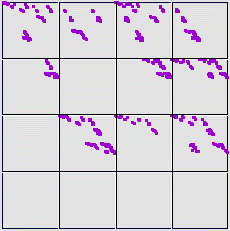| 12. Here is the equal size driven IFS using one-step differences. The addresses |
| 11, 12, 13, 21, 22, and 32 |
| are empty. So the smallest differences must be preceded by the largest. |
| Recall we are
discussing values, not magnitudes. The smallest difference is negative, the largest is positive. |
| On the other hand, the largest differences can follow any size difference. |
| No difference in
either of the smallest two groups can follow another in that group. |
| Also, while a bin 2 difference
can follow a bin 3 difference, a bin 3 difference cannot follow a bin 2 difference. |

